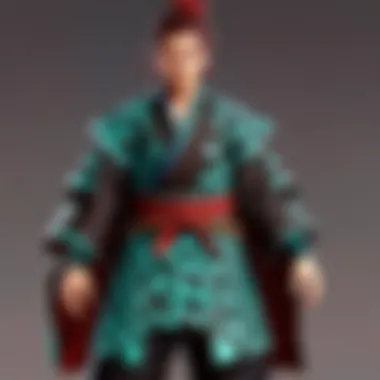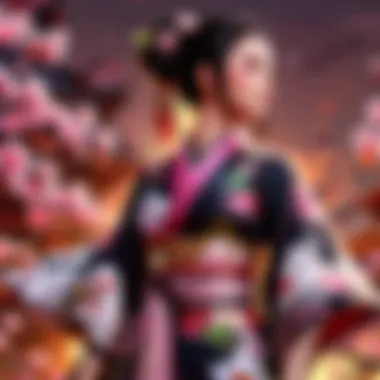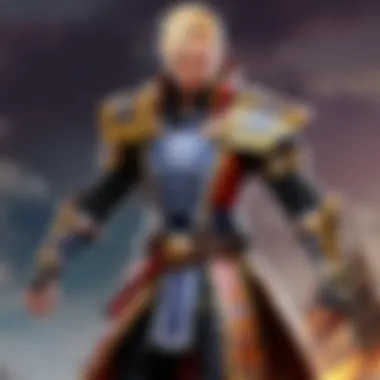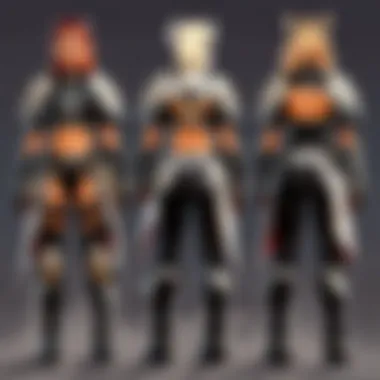Demon Slayer Outfits: Unveiling Cultural Significance and Trends


Intro
Demon Slayer has dominated both the world of anime and manga since its debut. With intricate story arcs and compelling characters, much of this allure comes from the diverse range of outfits worn by the characters. Garb in this series is not just a matter of aesthetics; it symbolizes the personalities, backgrounds, and historical eras showcased throughout the storyline.
Every outfit reflects cultural elements that resonate with Japanese traditions. The craftsmanship involved is noteworthy. Creating each character’s look involved detailed artwork that honors the historical authenticity of traditional clothing. Throughout this comprehensive exploration, we once explore the clothing's significance while gaining insight in a way that aligns with character development, the plot, and vital themes exhibited in the Demon Slayer narrative.
Historical Context of Outfits
In examining the outfits of Demon Slayer, understanding their historical roots provides critical context. Traditional Japanese clothing, such as the kimono, influenced much of the designs. You can identify various historical periods reflected in character attire. When observing Tanjiro Kamado, the use of the Hemp Leaf pattern not only signifies a connection to nature but also aligns with the common practice of wearing motifs regarded as good fortune in Japan.
Additionally, female characters showcase garments that portray the beauty standards of their respective times. For instance, Kanao Tsuyuri wears a modified kimono. This design blends cultural aesthetic with functionality, a theme often hurtled across the series. Thus, tactically adapting historical fashion caters to narrative progression while retaining visual respect for traditional styles.
Character-Specific Outfit Analysis
Every primary character presents a unique outfit that encapsulates their essence. Examining these designs can evoke understanding about their nature and background extensively.
- Tanjiro Kamado: His outfit consists of a combination of a haori and a checkered kimono that reflects his noble heart and determination. The vaporizing tone mirrors his unwavering will.
- Nezuko Kamado: Her attire, with its simple yet elegant design, channels both her human and demon side. Elements of traditional women's wear intertwine with a modern sense, effortlessly.
- Zenitsu Agatsuma: He wears bold colors that signify his flashy personality, utilizing asymmetric patterns that echo his unpredictable nature.
Each character’s design acts as a visual shorthand conveying deeper narrative constructs within their arcs.
Cultural Influences
Demon Slayer outfits reveal a plethora of cultural influences extending from the local to the mythical. The usage of symbols, much like the reference to various deities and traditional practices throughout the show, serves myriad purposes from simple appearances to intricate narratives spanning cultural angles.
The incorporation of unique attire like Tengen Uzui's flamboyant outfits illustrates the convergence of audacity and cultural interpretation, brandishing notions associated with shinobi and intertwined artisanal craftsmanship. Such elements forge identity beyond superficial fashion, establishing connections with viewers around themes immersed in historical lore.
Preamble to Demon Slayer Outfits
The outfit choices in Demon Slayer are much more than mere fabric and threads. They embody the characters' essence, promoting an understanding of their identities and motivations. This is why exploring Demon Slayer outfits provides valuable insights into the series. Each character’s attire tells a story, serving not only practical purposes but also creative expressions rooted in tradition.
Overview of the Series
Demon Slayer: Kimetsu no Yaiba is an anime and manga that resonates massively with audiences. It narrates the adventures of Tanjiro Kamado, a young boy who strives to save his sister and avenge his family after an unforeseen tragedy involving demons. Within this framework, outfits play a significant role. They help to frame the narrative and distinguish character attributes. The popularity of the series can be partly attributed to its remarkable visual style — and that includes the clothing worn by each character.
The Role of Outfits in Storytelling
In Demon Slayer, outfits serve multiple storytelling functions. They establish hierarchy among characters, indicating who holds power or is a newcomer. For instance, the specific designs of the Demon Slayer Corps uniforms convey a sense of camaraderie and style backed by sheer dedication while contrasting sharply with demon antagoniests’ bizarre appearances.
Moreover, the color schemes and patterns are not just aesthetically appealing; these elements have implications. For example, characters donning earthy tones often symbolize loyalty and strength, while brighter colors tend to indicate unique abilities or emotional states. This visual language engages the audience's cognitive and emotional faculties, augmenting the richness of the storyline.
"Understanding the significance behind the outfits can deepen one's appreciation for Demon Slayer, revealing layers of meaning often overlooked at first glance."
Thus, the exploration of Demon Slayer outfits is not a superficial undertaking. It provides key context that enhances character motivations and enriches the viewer's understanding of underlying themes.
Character-Specific Outfits
Character-specific outfits in Demon Slayer serve as visual canvases, illustrating not only personality but also the background of each character. These choices are enriching storytelling elements. Each outfit tells a story and connects viewers with the characters on a personal level. The design choices are there to represent emotional arcs, challenges, and personal growth of the characters. Thus, understanding these outfits deepens our connection to the narrative.


Tanjiro Kamado's Attire
Design Elements
Tanjiro's outfit combines practicality with rich symbolism. It features a black and green checkered haori, which offers a balance between aesthetic appeal and battle readiness. This design choice integrates functionality that resonates with Takani’s character – a blend of traditional craftsmanship and a modern warrior's style. The unique checkerboard pattern sets Tanjiro apart visually, allowing him to stand out while providing a connection to traditional Japanese clothing. This duality enhances its impact as a pivotal part of his narrative journey.
Cultural Significance
Tanjiro's attire reflects deeper cultural sentiments. The integration of the haori is significant, as it signifies respect for history and traditions. This choice not only honors his heritage but connects him to the world he operates within – a world where past and present intertwine in the face of adversity. Furthermore, wearing this attire while engaging in battle draws additional meaning, showcasing resilience and adherence to tradition, which resonates with audiences familiar with Japanese culture.
Nezuko Kamado's Kimono
Aesthetic Features
Nezuko’s kimono features intricate floral patterns that exemplify beauty and fragility. The main color palette incorporates soft pinks and browns to reflect her gentler side, juxtaposed with the fierce combat performance she showcases later on. This aesthetic are a depiction of eternal beauty, often coupled with portrayals of materials used in Japanese elegance. Nezuko’s garment becomes a visual juxtaposition. It stands vividly in every scene, attracting viewer's attention and reinforcing her dual nature.
Symbolism of Colors
The colors in Nezuko's outfit are significant. The use of pink suggests a sense of nurture and kindness. Meanwhile, darker elements hint at darkness she battles within. This outward appearance illustrates her struggle between humanity and her demonic existence. The symbolism extends; each color choice contributes to the storytelling throughout her character's journey. It embodies discipline and realization, capturing the viewer's empathy without saying a word.
Zenitsu Agatsuma's Style
Inspiration Behind the Look
Zenitsu's style draws heavily from traditional Japanese influences but also acknowledges modern elements that speak to contemporary sensibilities. His distinct yellow kimono stands out due to the striking contrast to his characteristic fearful personality. The design intends to inspire while serving a secondary function, like refuge and security through familiar motifs. This dual impression helps audiences relate to him, making him a more layered character in the Demon Slayer narrative.
Evolution Throughout the Series
As the series progresses, Zenitsu’s outfit evolves symbolizing his personal growth. What begins as a fearful, simplistic style transitions to a well-crafted ensemble that speaks volumes about his journey. It demonstrates increasing confidence and capability, showcasing the growth of the character. Different elements may appear highlighting spikes of confrontations and emotions, reinforcing a connection between visual elements and storyline development, which resonates with audience deeply.
Themes Reflected in Outfits
The outfits in Demon Slayer carry deeper meanings, resonating themes such as heroism, tradition, and the balance between old and new. Their portrayal not only enhances character depth but communicates larger societal narratives inherent in Japanese culture.
Heroism and Strength
Symbolic Representation
The ensembles donned by various characters in Demon Slayer are not merely about aesthetic appeal; they serve as symbols of their strength and heroism. For instance, Tanjiro's distinct kimono and Haori signify his role as a protector in the face of relentless challenges. The correlation between the outfits and their corresponding narratives positions them as effective representations of bravery. This graphic visualization allows viewers to connect emotionally with characters who defy adversity, making symbolic representation a pivotal aspect of the article. One key element here is that such garments often communicate an inner resolve and highlight goals beyond mere survival.
Visual Impact on Viewers
Visual impressions can have profound effects because they communicate meanings and evoke sentiments swiftly. Visual impact on viewers lies in the ability of a character’s outfit to enhance storytelling. Zenitsu’s vibrant yellow attire illustrates his exuberant personality and underlines moments of panic and valor. The effective use of color and design grabs attention, prompting viewers to forge connections with various aspects of the story. The vibrant hues can elicit responses from viewers, enhancing their experience and keeping them engaged with the overall narrative arc. However, a challenge arises if an outfit overwhelms characters. Instead of performing as amplifiers of character depth, the designs risk overshadowing personality nuances. Maintaining the right balance is therefore essential.
Tradition vs.
Modernity


Cultural Artifacts
Cultural artifacts play a significant role in shaping outfits within the Demon Slayer universe, grounding them in historical contexts yet portraying modern influences as well. The characters’ alignments within the traditional attire bring depth and invite audiences to appreciate their cultural milieu. For example, Nezuko's kimono echoes Japan's lengthy heritage of textile craftsmanship yet allows viewers to witness how characters embody historical nature in modern settings. Cultural artifacts in outfits highlight significance beyond material existence— they tell stories infused with values synchronizing with main themes, inviting viewers to reflect on cultural continuity. Yet, historical artifacts can hinder creative expression by constricting designs adhering strictly to tradition, warranting awareness of a balance to foster innovative interpretations.
Fusion in Design
The melding of different design elements creates intriguing outfits that reflect how tradition adapts. This fusion in design juxtaposes ornamental aspects with contemporary styles, resonating with a diverse audience’s sensibilities. The integration serves to shape new narratives that move past strict aesthetics, paving pathways to new dialogues about identity and types of beauty. Charming yet modern attributes seen in helmets or modern cuts in dresses stir interest and excitement ascetically engaged cultivators, but it also harbors complexities of interpretation in society. Balancing explosive imagination and tranquil tradition makes the designer's task intricate. However, successfully merging both worlds can yield iconic outfits with longstanding impressions.
Ultimately, themes woven through the costumes of Demon Slayer serve an intrinsic narrative role. They not only illustrate character pulses but create a bridge leading fans to explore nuanced dialogues of existence and morality accented on screen.
The Influence of Japanese Culture
In examining the outfits featured in the Demon Slayer series, it is essential to reflect on the fundamental influence of Japanese culture. The artistry, symbolism, and representations within these outfits carry profound meanings that extend beyond mere clothing. Outfits are a visual narrative of Japan's rich heritage, addressing cultural nuances and offering insights into the characters' backgrounds. By focusing on this relationship, we can deepen our understanding of the series itself.
Kimono and Its Variations
Historical Context
The kimono represents the heritage of Japan, showcasing the evolution of Japanese fashion throughout the centuries. Historically, the garments were integral in social status identification, with style variations denoting age, gender, and marital status. Many character outfits reflect this historical significance by incorporating elements from various periods. For instance, the vibrant colors in Tanjiro's attire might draw inspiration from formal kimonos worn during special occasions.
Important aspects of historical context in the article include:
- Cultural layers: Each outfit's design often hides various references to traditional motifs, connecting the character to Japanese roots.
- Static vs. Dynamic: Historical kimono designs portray a static notion of culture, while the kinetic movements of characters show its evolution.
One unique feature to note is how the depiction of fabrics and cuts serve to illustrate social structures and relations, a beneficial choice for enriching an audience's appreciation of the series.
Aesthetic Appreciation
Aesthetic enjoyment of kimono and its variations aligns closely with the narrative aesthetics of Demon Slayer. The visually appealing fabrics and intricate patterns invite fans to explore the deeper essence of these outfits. This specific attention to the aesthetics enriches viewers' engagement, allowing them to not only appreciate the clothing but also the crafting of these character portrayals.
Key characteristics that emerge include:
- Visual Woulders: Intricate design catches the eye, creating emotional connections through beauty and precision.
- Interpretative layers: Observable characteristics lead audiences to question tradition and modern inspiration.
A unique feature of aesthetic appreciation lies in its ability to intertwine traditional elements with modern interpretations, subtly showcasing the historical transformation of identity through clothing.
The Concept of Wabi-Sabi
Philosophical Implications
The philosophy of wabi-sabi promotes an appreciation for imperfection and transience, ideals commonly manifested in various character outfits. Through this lens, one comprehends that beauty arises from the incomplete or imperfect, much akin to many Demon Slayer characters themselves, who carry strengths and vulnerabilities. This reflects the multifaceted nature of being human, encouraging authenticity in both fashion and character presentation.
- Depth of the theme: The characteristics provide diversity; wabi-sabi suggests a valuation of growth over superficial beauty, making it a useful theme in the article.
- Character depth: Understanding the allure of unique imperfections in clothing may present grounds for deeper character evaluations.
Notably, adopting wabi-sabi principles allows audiences to embrace imperfections in designs and characters, significantly enriching discussions surrounding them.
Aesthetic Choices


Wabi-sabi also shapes aesthetic choices within the series, as seen through the characters’ outfits that balance simplicity with grandeur. This is particularly evident in outfits that display natural dyes and simpler designs alongside more elaborate patterns. Utilization of these choices elicits feelings of nostalgia and rooted cultural connections.
Important points involve:
- Integration of past and modern: Adaptation of traditional textiles into contemporary designs supports a relatable influence among the audience.
- Emphasizing the transient: Efforts to create an ambience of natural decay evoke emotional responses, contributing to modes of connection that benefit narrative depth.
The incorporation of aesthetic choices influenced by wabi-sabi builds a cohesive foundation in relaying deeper cultural commentary in Demon Slayer, allowing for richer engagements with its attire in effect.
Though there might be varying interpretations of style, recognizing the stretched boundaries of beauty as explored in the series unfolds another layer of understanding amidst this rich cultural tapestry.
Outfit Trends and Fandom Extensions
The trends surrounding Demon Slayer outfits have created an expansive fandom expression that extends beyond the series itself. This section delves into various facets of cosplay culture and fashion collaborations that highlight the significant impacts of these trends in the modern landscape of anime series.
Cosplay Culture
Creating Accurate Replicas
Creating accurate replicas of Demon Slayer outfits has transformed into a dedicated art within the fandom. Attention to detail is a key characteristic, as fans take great pride in ensuring that their costumes accurately reflect the characters’ styles and attributes. This precision not only enhances the visual authenticity of their representations but also strengthens their connection to the story and characters.
Fans often choose to create these replicas using high-quality materials. This decision allows for costumes that stand the test of time, showcasing the artistry involved. However, it can also be a financial investment, leading some cosplayers to explore lower-cost alternatives as means to create their desired looks.
Community Engagement
Community engagement plays a vital role in the cosplay culture around Demon Slayer outfits. Various events, such as conventions, provide platforms for fans to bond over their shared passions. This interaction fosters a sense of belonging and creates opportunities for collaboration. When engaging with peers, the enthusiasm for mutual interests fuels creativity and encourages the exchange of techniques and resources.
Through online platforms like reddit.com and dedicated cosplay forums, individuals share costume progress and seek feedback. This aspect is invaluable as it empowers continuous improvement and provides motivation. Nevertheless, while community feedback can be uplifting, it also has the risk of imposing unnecessary pressure on cosplayers to achieve perfection.
Fashion Collaborations
Brands Inspired by Demon Slayer
The influence of Demon Slayer outfits has reached notable fashion brands, prompting unique collaborations inspired by the series. A primary characteristic of brands welcoming this initiative is their sense of impuls undercurrent in adapting elements of anime culture into ready-to-wear collections. This blending of fantasy with fashion allows the fandom to immortalize its favorite characters into daily lives.
One prominent example includes UNIQLO, which has launched clothing lines featuring motifs and symbols from the series. Brands gain a competitive edge in the market, tapping into an enthusiastic customer base that connects deeply with the series’ themes and characters. The downside is that while many brands seek authenticity, others may superficially integrate elements merely for profit, risking an over-commercialization of fandom.
Market Impact
The crossover effects of Demon Slayer outfits on market dynamics are visible. With increasing popularity, various products related to the series have emerged, boosting sales significantly of not only fashion items but also merchandise. Retailers such as Hot Topic and BoxLunch report heightened demands for related items, driven by collectors and casual fans alike.
The influence of the market is such that brands often create limited-edition collections that celebrate specific characters or moments. These products can be a double-edged sword: high demand often leads to quick sell-outs but risks alienating those unable to participate in the rush. By diversifying offerings over time, retailers can reach a broader audience while nurturing the fervent loyalty that fans demonstrate to their beloved series.
The convergence of anime culture with contemporary fashion illustrates a meaningful evolution in the Demon Slayer fandom, illustrating both opportunities and trials within creative expression.
Epilogue
The examination of Demon Slayer outfits offers various insights into not just aesthetic elements but also cultural influences and thematic narratives within the series. Outfits are not mere visual flourishes; they serve to accentuate character traits, emotional arcs, and underlying philosophies. This comprehensive analysis reveals how costume design intersects with storytelling, impacting viewers' perceptions and the greater story of Demon Slayer.
The Lasting Impact of Demon Slayer Outfits
Demon Slayer outfits leave a significant mark on both the narrative and the audience. These designs encapsulate character development, representing both personal struggles and revelations. For instance, Tanjiro's distinctively colored kimono signifies his familial ties and resilience. Similarly, Nezuko's attire introduces themes of transformation and identity.
Additionally, the intricate details woven into each character's outfit reflect Japan's rich cultural heritage. The act of donning these costumes transcends simple representation; it fees a sense of belonging and cultural identity in viewers and fans alike. Outfits spark discussions and reflections on tradition, modernity, and the relevance of historical contexts to contemporary life.







